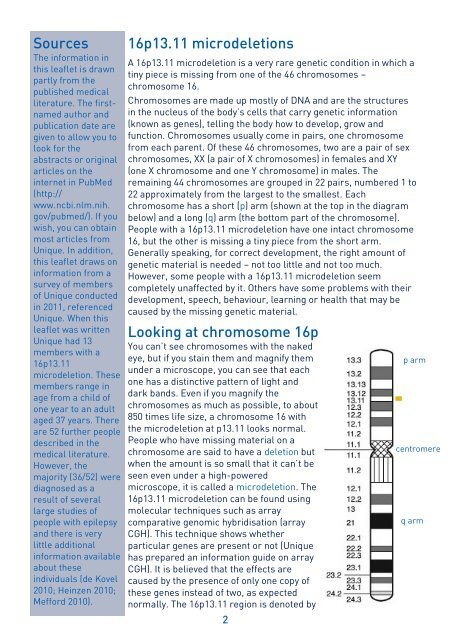16p13.11 microdeletions - Unique - The Rare Chromosome ...
16p13.11 microdeletions - Unique - The Rare Chromosome ...
16p13.11 microdeletions - Unique - The Rare Chromosome ...
Create successful ePaper yourself
Turn your PDF publications into a flip-book with our unique Google optimized e-Paper software.
Sources<br />
<strong>The</strong> information in<br />
this leaflet is drawn<br />
partly from the<br />
published medical<br />
literature. <strong>The</strong> firstnamed<br />
author and<br />
publication date are<br />
given to allow you to<br />
look for the<br />
abstracts or original<br />
articles on the<br />
internet in PubMed<br />
(http://<br />
www.ncbi.nlm.nih.<br />
gov/pubmed/). If you<br />
wish, you can obtain<br />
most articles from<br />
<strong>Unique</strong>. In addition,<br />
this leaflet draws on<br />
information from a<br />
survey of members<br />
of <strong>Unique</strong> conducted<br />
in 2011, referenced<br />
<strong>Unique</strong>. When this<br />
leaflet was written<br />
<strong>Unique</strong> had 13<br />
members with a<br />
<strong>16p13.11</strong><br />
microdeletion. <strong>The</strong>se<br />
members range in<br />
age from a child of<br />
one year to an adult<br />
aged 37 years. <strong>The</strong>re<br />
are 52 further people<br />
described in the<br />
medical literature.<br />
However, the<br />
majority (36/52) were<br />
diagnosed as a<br />
result of several<br />
large studies of<br />
people with epilepsy<br />
and there is very<br />
little additional<br />
information available<br />
about these<br />
individuals (de Kovel<br />
2010; Heinzen 2010;<br />
Mefford 2010).<br />
<strong>16p13.11</strong> <strong>microdeletions</strong><br />
A <strong>16p13.11</strong> microdeletion is a very rare genetic condition in which a<br />
tiny piece is missing from one of the 46 chromosomes –<br />
chromosome 16.<br />
<strong>Chromosome</strong>s are made up mostly of DNA and are the structures<br />
in the nucleus of the body’s cells that carry genetic information<br />
(known as genes), telling the body how to develop, grow and<br />
function. <strong>Chromosome</strong>s usually come in pairs, one chromosome<br />
from each parent. Of these 46 chromosomes, two are a pair of sex<br />
chromosomes, XX (a pair of X chromosomes) in females and XY<br />
(one X chromosome and one Y chromosome) in males. <strong>The</strong><br />
remaining 44 chromosomes are grouped in 22 pairs, numbered 1 to<br />
22 approximately from the largest to the smallest. Each<br />
chromosome has a short (p) arm (shown at the top in the diagram<br />
below) and a long (q) arm (the bottom part of the chromosome).<br />
People with a <strong>16p13.11</strong> microdeletion have one intact chromosome<br />
16, but the other is missing a tiny piece from the short arm.<br />
Generally speaking, for correct development, the right amount of<br />
genetic material is needed – not too little and not too much.<br />
However, some people with a <strong>16p13.11</strong> microdeletion seem<br />
completely unaffected by it. Others have some problems with their<br />
development, speech, behaviour, learning or health that may be<br />
caused by the missing genetic material.<br />
Looking at chromosome 16p<br />
You can’t see chromosomes with the naked<br />
eye, but if you stain them and magnify them<br />
under a microscope, you can see that each<br />
one has a distinctive pattern of light and<br />
dark bands. Even if you magnify the<br />
chromosomes as much as possible, to about<br />
850 times life size, a chromosome 16 with<br />
the microdeletion at p13.11 looks normal.<br />
People who have missing material on a<br />
chromosome are said to have a deletion but<br />
when the amount is so small that it can’t be<br />
seen even under a high-powered<br />
microscope, it is called a microdeletion. <strong>The</strong><br />
<strong>16p13.11</strong> microdeletion can be found using<br />
molecular techniques such as array<br />
comparative genomic hybridisation (array<br />
CGH). This technique shows whether<br />
particular genes are present or not (<strong>Unique</strong><br />
has prepared an information guide on array<br />
CGH). It is believed that the effects are<br />
caused by the presence of only one copy of<br />
these genes instead of two, as expected<br />
normally. <strong>The</strong> <strong>16p13.11</strong> region is denoted by<br />
2<br />
p arm<br />
centromere<br />
q arm

















